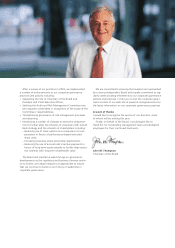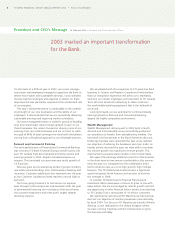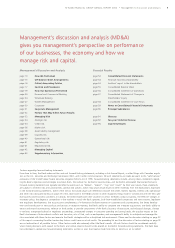TD Bank 2003 Annual Report Download - page 17
Download and view the complete annual report
Please find page 17 of the 2003 TD Bank annual report below. You can navigate through the pages in the report by either clicking on the pages listed below, or by using the keyword search tool below to find specific information within the annual report.TD BANK FINANCIAL GROUP ANNUAL REPORT 2003 • Management’s Discussion and Analysis 15
In the normal course of operations, the Bank engages in a
variety of financial transactions that, under generally
accepted accounting principles, are either not recorded on
the Consolidated Balance Sheet or are recorded in amounts
that differ from the full contract or notional amounts. These
off-balance sheet arrangements involve, among other risks,
varying elements of market, credit and liquidity risk which
are discussed in the Managing risk section on pages 33 to
41 of this Annual Report. Off-balance sheet arrangements
are generally undertaken for risk management, capital
management and/or funding management purposes and
include securitizations, commitments, guarantees and
contractual obligations.
Securitizations
Securitizations are an important part of the financial markets,
providing liquidity by facilitating investor access to specific
portfolios of assets and risks. In a typical securitization
structure, the Bank sells assets to a special purpose entity
(SPE) and the SPE funds the purchase of those assets by
issuing securities to investors. SPEs are typically set up for a
single, discrete purpose, are not operating entities and
usually have no employees. The legal documents that govern
the transaction describe how the cash earned on the assets
held in the SPE must be allocated to the investors and other
parties that have rights to these cash flows. The Bank is
involved in SPEs through the securitization of its own assets,
securitization of third party assets and other financial
transactions.
Securitization of bank-originated assets
The Bank securitizes residential mortgages, personal loans,
credit card loans and commercial mortgages to enhance its
liquidity position, diversify its sources of funding and to
optimize the management of its balance sheet. Details of
these securitizations are discussed below.
The Bank securitizes residential mortgages through the
creation of mortgage-backed securities and transfers to SPEs.
The Bank continues to service the securitized mortgages and
may be exposed to the risks of the transferred loans through
retained interests. There are no expected credit losses on the
retained interests of the securitized residential mortgages
that are government guaranteed (approximately 94% of all
securitized residential mortgages). As at October 31, 2003,
the Bank had outstanding securitized residential mortgages
of $11.3 billion as compared with $8.1 billion in fiscal 2002.
The Bank securitizes real estate secured personal loans
through sales to SPEs. The Bank provides credit enhancement
through its retained interest in the excess spread of the SPEs
and by funding cash collateral accounts. The Bank’s interest in
the excess spread of the SPEs and the cash collateral account
is subordinate to the SPEs’ obligations to the holders of its
asset-backed securities and absorbs losses with respect to
the personal loans before payments to noteholders are
affected. As at October 31, 2003, the Bank had outstanding
securitized personal loans of $4.6 billion as compared with
$5.0 billion in fiscal 2002.
The Bank securitizes credit card loans through sales to
SPEs. The Bank’s credit card securitizations are revolving
securitizations, with new credit card receivables transferred to
the SPEs each period to replenish receivable amounts as they
are repaid. The Bank provides credit enhancement to the SPEs
through its retained interest in the excess spread. The Bank’s
interest in the excess spread of the SPEs is subordinate to the
SPEs’ obligations to the holders of its asset-backed securities
and absorbs losses with respect to the credit card receivables
before payments to the noteholders are affected. As at
October 31, 2003, the Bank had outstanding securitized credit
card receivables of $1.5 billion as compared with $1.5 billion
in fiscal 2002.
The Bank also securitizes commercial mortgages, which
in addition to providing a source of liquidity and capital
efficient funding, may reduce the Bank’s credit exposure. As
at October 31, 2003, the Bank had outstanding securitized
commerical mortgages of $1.0 billion as compared with
$.3 billion in fiscal 2002.
Total bank-originated securitized assets not included on
the Consolidated Balance Sheet amounted to $18.4 billion
compared with $14.9 billion a year ago. Further details are
provided in Note 4 of the Bank’s Consolidated Financial
Statements.
Securitization of third party originated assets
The Bank assists its clients in securitizing their financial
assets through SPEs administered by the Bank. The Bank
may provide credit enhancement or liquidity facilities to the
resulting SPEs as well as securities distribution services. The
Bank does not provide employees to the SPEs, nor does it
have ownership interests in these SPEs and all fees earned
in respect of these activities are on a market basis.
Other financial transactions
The Bank sells trading securities to SPEs in conjunction with
its balance sheet management strategies. The Bank does not
retain effective control over the assets sold. Assets sold under
such arrangements at October 31, 2003 amounted to $5.0
billion as compared with $5.0 billion in fiscal 2002. The Bank
enters into total return swaps with the sale counterparties in
respect of the assets sold. Market risk for all such transactions
is tracked and monitored, and market risk capital is required.
In addition, the Bank also offers financial products,
including mutual funds, structured notes and other financial
instruments to clients, including SPEs as counterparties.
These financial products are, on occasion, created using a
SPE as issuer or obligor of the financial products. The Bank
may provide certain administrative services and other
financial facilities to the SPEs in exchange for market
rate compensation.
Commitments and guarantees
Details of the Bank’s commitments and guarantees are provided
in Note 19 of the Bank’s Consolidated Financial Statements.
Contractual obligations
The Bank has contractual obligations to make future
payments on subordinated notes and debentures, operating
lease commitments, capital trust securities and certain
purchase obligations. Subordinated notes and debentures
and capital trust securities are reflected on the Bank’s
Consolidated Balance Sheets, while operating lease
commitments and purchase obligations are not. Details of
these contractual obligations as at October 31, 2003 are
disclosed by remaining maturity in supplementary table 17
on page 53 of this Annual Report.
Off-balance Sheet Arrangements
























